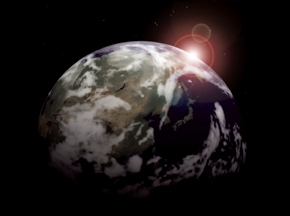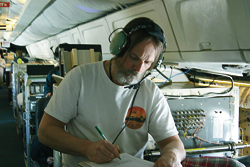Celebrating Earth's Thawing Polar Regions,
Studying Them From On High
The Fourth International Polar Year was intended to entice the public and stimulate interest in climate change. Unfortunately, the program got quite a bit of help from the poles themselves.
“When IPY was dreamed up five years ago nobody would have expected to see the extent of the melt we saw last summer in the Arctic Ocean or the vastly accelerating discharge of the Greenland ice sheet,” says scientist Jack Dibb of the Climate Change Research Center. Antarctica, too, has been the site of some dramatic melting and loss of ice sheets.
As part of a field campaign conducted under the IPY banner, Dibb, along with CCRC colleague Eric Scheuer, spent the better part of April in NASA’s DC-8 “flying laboratory” cruising above the Arctic region sniffing for pollutants transported from near and far.
The Arctic Research of the Composition of the Troposphere from Aircraft and Satellites, ARCTAS for short, is the most extensive field campaign ever conducted to investigate the chemistry of the Arctic’s lower atmosphere. The mission is poised to help scientists identify how air pollution contributes to climate changes in the Arctic.
Explains Dibb, “People are really concerned about the changes happening in the Arctic. There are burning scientific questions about how atmospheric composition might be driving those changes and, in turn, how the changing Arctic might cause feedback and further modify atmospheric composition.”
The Arctic is a particularly vulnerable place, subject to dramatic amplification of environmental change with possibly global consequences. Changes have occurred so rapidly that the Arctic has been referred to as the “poster child” of global change. It is where warming has been strongest over the past century, and has accelerated over the past decades.
The region is an atmospheric receptor of pollution from the northern mid-latitude continents, as manifested in particular by thick aerosol layers known as “Arctic haze,” and by the accumulation of persistent pollutants such as mercury—a toxin being measured by UNH instruments onboard the DC-8 for CCRC’s Bob Talbot and Huiting Mao. Dibb and Scheuer are measuring gaseous nitric acid—a byproduct of pollutants emitted by car and truck engines, and particles in the atmosphere known as aerosols.
The Arctic is increasingly beset by emissions from massive forest fires in boreal Eurasia and North America—something the second phase of the campaign will investigate. Changes to the Arctic environment trigger unique regional responses including melting of ice sheets and permafrost, decrease in snow albedo (reflectivity) due to deposition of black carbon (soot), and chemical processes driven by sea salt aerosols deposited to the ice.
Soot has traditionally been thought to play a small role in Arctic climate change, but recently published reports suggest its influence might be greater than suspected. Increased industrialization of Asia and the increasing numbers and extent of boreal wild fires have paralleled the observations of earlier and more extensive melting (of snow, ice, and permafrost) throughout the Arctic. Long-range transport of soot from these sources may reduce the albedo of the Arctic cryosphere and accelerate the melting. Currently, says Dibb, “There’s a push to find out if greater amounts of imported soot and melting in the Arctic are really directly linked.”
The campaign began during the first week in April in Fairbanks, Alaska. Three NASA aircraft, including the DC-8, served as airborne laboratories for the three weeks.
Of particular interest to scientists is the formation of the springtime Arctic haze. The return of sunlight to the Arctic in the spring fuels chemical reactions of pollutants that have accumulated over the winter after traveling long distances from lower latitudes. For example, before the Soviet Union collapsed, dirty air from heavy industry wafted from Russia into what people assumed was a relatively pristine Arctic region. After a noticeable post-USSR decline in this pollution, the industrialization of Southeast Asia is driving what appears to be a resurgence of the long-range transport of polluted air masses.
The wealth of data collected will also improve computer models used to study global atmospheric chemistry and climate, and the new aircraft observations will help researchers interpret data from NASA satellites—such as Aura, Terra, and Cloud-Aerosol Lidar and Infrared Pathfinder Satellite Observation (CALIPSO)—orbiting over the Arctic. Interpreting satellite data can be difficult in the region because of extensive cloud cover, bright reflective surfaces from snow and ice, and cold surface temperatures.
Notes Dibb, “The open questions about what’s going on in the Arctic with rapid change make a lot of people really want to push the satellites as hard as they can, in terms of getting accurate data.” The in situ measurements made by the aircraft will be invaluable with respect to corroborating what satellites are “seeing” remotely.
ARCTAS is part of a larger interagency and international IPY effort collectively identified as POLARCAT, which will execute a series of aircraft experiments at different times of the year.
In order to have full and equal coverage of both the Arctic and the Antarctic, IPY 2007-8 covers two full annual cycles from March 2007 to March 2009 and will involve over 200 projects, with thousands of scientists from over 60 nations examining a wide range of physical, biological and social research topics.
For more on the International Polar Year and ARCTAS visit www.ipy.org and www.epo.nasa.gov/arctas, respectively.
“When IPY was dreamed up five years ago nobody would have expected to see the extent of the melt we saw last summer in the Arctic Ocean or the vastly accelerating discharge of the Greenland ice sheet,” says scientist Jack Dibb of the Climate Change Research Center. Antarctica, too, has been the site of some dramatic melting and loss of ice sheets.
Jack Dibb records aerosol data aboard NASA's DC-8 "flying laboratory." Photo: Glenn Shaw, Univ. Alaska Faribanks |
The Arctic Research of the Composition of the Troposphere from Aircraft and Satellites, ARCTAS for short, is the most extensive field campaign ever conducted to investigate the chemistry of the Arctic’s lower atmosphere. The mission is poised to help scientists identify how air pollution contributes to climate changes in the Arctic.
Explains Dibb, “People are really concerned about the changes happening in the Arctic. There are burning scientific questions about how atmospheric composition might be driving those changes and, in turn, how the changing Arctic might cause feedback and further modify atmospheric composition.”
The Arctic is a particularly vulnerable place, subject to dramatic amplification of environmental change with possibly global consequences. Changes have occurred so rapidly that the Arctic has been referred to as the “poster child” of global change. It is where warming has been strongest over the past century, and has accelerated over the past decades.
The region is an atmospheric receptor of pollution from the northern mid-latitude continents, as manifested in particular by thick aerosol layers known as “Arctic haze,” and by the accumulation of persistent pollutants such as mercury—a toxin being measured by UNH instruments onboard the DC-8 for CCRC’s Bob Talbot and Huiting Mao. Dibb and Scheuer are measuring gaseous nitric acid—a byproduct of pollutants emitted by car and truck engines, and particles in the atmosphere known as aerosols.
The Arctic is increasingly beset by emissions from massive forest fires in boreal Eurasia and North America—something the second phase of the campaign will investigate. Changes to the Arctic environment trigger unique regional responses including melting of ice sheets and permafrost, decrease in snow albedo (reflectivity) due to deposition of black carbon (soot), and chemical processes driven by sea salt aerosols deposited to the ice.
Soot has traditionally been thought to play a small role in Arctic climate change, but recently published reports suggest its influence might be greater than suspected. Increased industrialization of Asia and the increasing numbers and extent of boreal wild fires have paralleled the observations of earlier and more extensive melting (of snow, ice, and permafrost) throughout the Arctic. Long-range transport of soot from these sources may reduce the albedo of the Arctic cryosphere and accelerate the melting. Currently, says Dibb, “There’s a push to find out if greater amounts of imported soot and melting in the Arctic are really directly linked.”
The Brooks Range of Alaska form the NASA DC-8. Photo: Eric Scheuer, UNH-EOS |
Of particular interest to scientists is the formation of the springtime Arctic haze. The return of sunlight to the Arctic in the spring fuels chemical reactions of pollutants that have accumulated over the winter after traveling long distances from lower latitudes. For example, before the Soviet Union collapsed, dirty air from heavy industry wafted from Russia into what people assumed was a relatively pristine Arctic region. After a noticeable post-USSR decline in this pollution, the industrialization of Southeast Asia is driving what appears to be a resurgence of the long-range transport of polluted air masses.
The wealth of data collected will also improve computer models used to study global atmospheric chemistry and climate, and the new aircraft observations will help researchers interpret data from NASA satellites—such as Aura, Terra, and Cloud-Aerosol Lidar and Infrared Pathfinder Satellite Observation (CALIPSO)—orbiting over the Arctic. Interpreting satellite data can be difficult in the region because of extensive cloud cover, bright reflective surfaces from snow and ice, and cold surface temperatures.
Notes Dibb, “The open questions about what’s going on in the Arctic with rapid change make a lot of people really want to push the satellites as hard as they can, in terms of getting accurate data.” The in situ measurements made by the aircraft will be invaluable with respect to corroborating what satellites are “seeing” remotely.
ARCTAS is part of a larger interagency and international IPY effort collectively identified as POLARCAT, which will execute a series of aircraft experiments at different times of the year.
In order to have full and equal coverage of both the Arctic and the Antarctic, IPY 2007-8 covers two full annual cycles from March 2007 to March 2009 and will involve over 200 projects, with thousands of scientists from over 60 nations examining a wide range of physical, biological and social research topics.
For more on the International Polar Year and ARCTAS visit www.ipy.org and www.epo.nasa.gov/arctas, respectively.
by David Sims, Science Writer, Institute for the Study of Earth, Oceans, and Space. Published in Spring 2008 issue of EOS .


